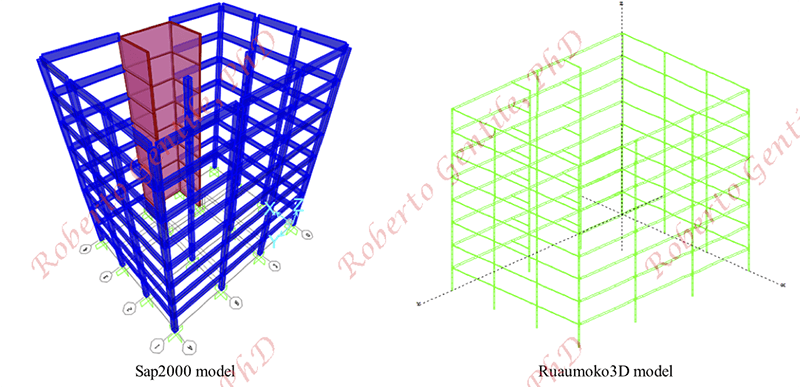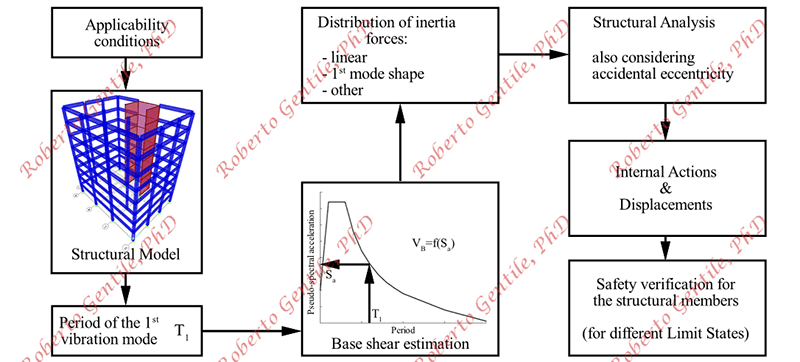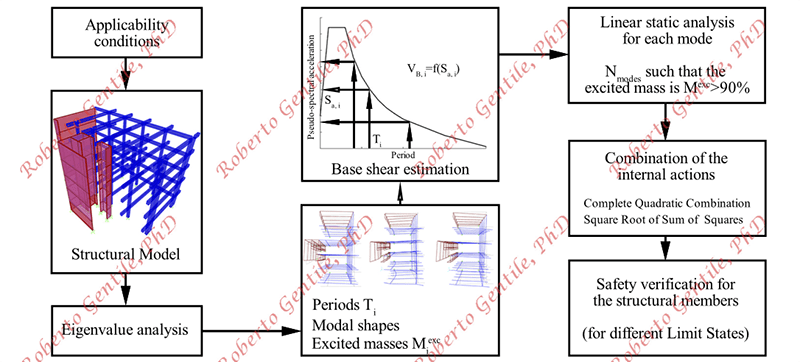Numerical Modeling
 In the last years, I gained some experience with numerical modelling of structures using different software. Here I show some examples, mainly related to seismic assessment.
In the last years, I gained some experience with numerical modelling of structures using different software. Here I show some examples, mainly related to seismic assessment. Linear Static Analysis
In this approach, a series of forces acting on the building is defined to represent the effect of earthquake ground motion, typically defined by a seismic design response spectrum. It is assumed that the behaviour of the building is mostly dominated by its fundamental mode of vibration. This is generally true for low-rise buildings without any significant in-plan strength and stiffness irregularities, for which higher modes and torsional effects are negligible. When this kind of elastic analysis is used, the lateral response can be captured up to the yielding of the first member, since no redistribution of internal actions can be captured. Generally, reduction factors are used when defining the applied forces, to consider the non-linear behaviour in an approximate way.
Modal Response Spectrum Analysis (Linear Dynamic)
The Modal Response Spectrum Analysis, often called Linear Dynamic, is the reference method commonly used to design new buildings. This method allows to consider higher mode effects within the elastic range. Firstly, a numericallybased eigenvalue analysis is carried out to determine the elastic dynamic properties of the building (shape of the principal vibration modes, natural frequencies, excited mass, etc). A criteria related to the effective mass excited in each principal vibration mode is therefore used to select a group of significant modes. A Linear Static Analysis is conducted for each of them basing on the modal shape, the participating mass and a design response spectrum. The resulting modal effects (storey shear, displacements, internal actions, etc.) are combined using statistics-based approaches to estimate the likely maximum response of the building. Namely, the Square Root of the Sum of the Squares (SRSS) and the Complete Quadratic Combination (CQC) are the most common combination methods.
Pushover Analysis (Non-Linear Static)
A Non-Linear Static, or Pushover, Analysis is a method in which the structure is subjected to constant vertical loads (gravity) and varying horizontal loads such that the displacement of a selected point of the structure (control node) is monotonicallyincreasing (displacement-control Pushover). The horizontal loads, which represent the inertia forces in a simplified way, are modelled by means of forces applied at the centre of mass of each floor of the building. In the conventional Pushover methods, the distribution of the applied forces remains unchanged as the displacement of the control node increases.
Time History Analysis (Non-Linear Dynamic)
Non-Linear Time History Analysis (NLTHA) consists in calculating the time-dependent non-linear response of a structure whose supports are subjected to an acceleration time history. This is done by means of a numerically-based integration of the differential equations of motion, carried out using a computer software. Clearly, the numerical model should be able to capture the full non-linear response of the structural members, including hysteretic loading and unloading.This method is not intended to provide the structure response to one particular earthquake record, since both the demand and the capacity are affected by high uncertainties. Moreover, a number of assumptions are adopted in the construction of the numerical model, which is not able, regardless of its complexity, to capture all the possible failure mechanisms. With a fair trade-off between model complexity and capability, with this analysis method it is possible to obtain the most reliable estimation of the behaviour trend of the structure, provided that engineering judgement drives the modelling assumptions and the interpretation of the results.
